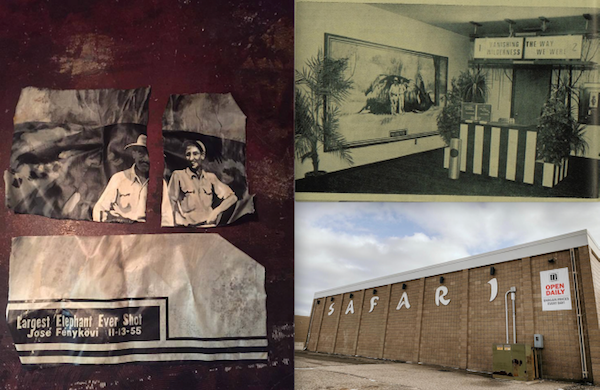Appreciation by Greg Carlson
The Safari, known more recently as the Marcus Safari 7 Discount and the Marcus Safari Value Cinema, has been sold to Ignite Church. The unsurprising news heralds the transition of Moorhead, Minnesota’s surviving public movie exhibitor from one kind of sanctuary to another. Like any cinema, the Safari brought people together to dream in the dark. This week, friends have shared many stories of memorable moviegoing experiences, birthday parties, tearful break-ups, first dates, and thrilling kisses — my own in the back row of auditorium one during a 1984 screening of “2010: The Year We Make Contact.”
The Safari opened in 1972 as a two-screen operation featuring a total of 850 seats, 550 in the big auditorium and 300 in side two. That the Safari lasted for nearly half a century is a remarkable achievement, considering how often it seemed on the verge of permanent closure. It was originally operated by the State Theatre Company, and would be managed by Cinema Entertainment Corporation for many years prior to its sale to Marcus.
The building itself, a nondescript concrete-walled box, was enlivened on the inside by the thematic decor in the lobby and auditoriums. The June 30, 1975 issue of Boxoffice notes, “The lobby features Master’s Carpet in a red and black shag design called Jubilee. A horseshoe-shaped refreshment counter and box office has sides paneled in broad zebra stripings of black and white.” I especially liked the colorful animal photos lining the walls of the second screen.
The article further describes the distinctive design aesthetic: “Safari-themed murals abound in the lobby and waiting areas. The murals were done by Jack Denst and Environmental Graphics with a custom photo supplied by CustomArt. Potted plants and chairs upholstered in zebra-striping material accent the decor.” And nobody who sat in one will ever forget the big cat print upholstery or the reclining action on the “rocker back” seats.
The lobby’s best-remembered mural, which was lost in a 2004 fire, showed an image with the inscription, “Largest Elephant Ever Shot, Jose Fenykovi, 11-13-55.” The actual creature stalked and felled by the Madrid businessman ended up mounted and prominently displayed at the National Museum of Natural History in Washington, D.C.
During its time as a first-run cinema, Safari was host to titles big and small, including many blockbusters. I will never forget standing in a line that snaked all the way around the building and well across the parking lot to get a ticket for “The Empire Strikes Back.” Or the girl so frightened by the cornfield reveal of E.T. that she tore off an armrest that landed in my father’s lap. Or the late-night preview of “Batman” that I ruined for myself by reading the already-available novelization because I was too curious and excited to wait.
When “Purple Rain” became a must-see phenomenon, Prince fans under the age of 17 headed for the Safari because the theater had a reputation for rather relaxed rules when it came to checking identification for entry to R-rated movies. My friend Heidi Taylor recalls, “I was in the 8th grade. We walked to the Safari and crossed the freeway ON FOOT to get there. Once inside, I said, ‘One for Purple Rain.’ My heart was pounding. I was 13. She said, ‘Are you 17?’ I said, ‘Yes I am.’ And I was in. One of those memories you never forget.”
At the end of my high school years, I acquired a job at the Century working for Rick Solarski, but several of my friends were employed at the Safari, and I spent as much time as ever, during and after hours, at my hometown haunt. By 1988, the Safari had expanded to seven total screens, and the last additions were insultingly small. We quickly christened the shoebox auditoriums the “Wesley Snipes Wing,” since a run of the star’s titles in the early 90s inevitably debuted in house four, five, six, and seven.
This past March, my friend Brent Brandt hosted a showing of “Stop Making Sense” to celebrate my birthday. It would be the final movie in Brent’s impressive run of private engagements at the Safari. The escalating pandemic quickly brought about the closure of many movie theaters to help slow the spread of COVID-19, and even at the time, I wondered whether the Safari would ever play another film. I’ll hold on to my happy recollections of dancing to the Talking Heads that night, and to the warm thoughts of the hundreds of films I saw over the years with Mike Scholtz and other movie-obsessed friends.
My fellow Moorhead Spud Kelly Phillips called the Safari a “pretty magical spot in a somewhat beige town,” and I can’t think of a better way to describe the Safari’s important role as our neighborhood movie house.
